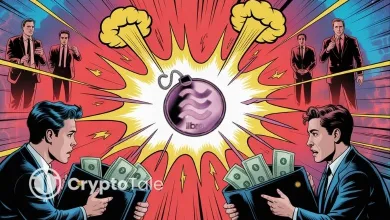Bitcoin Gains Power While US Confidence Hits Historic Low

- US sentiment dropped 11% in April, showing deep fear about the future of the economy
- Inflation expectations reached 6.7%, with fears of job losses growing nationwide.
- Bitcoin’s dominance rose to 62.71% amid strong futures and market participation.
U.S. consumer sentiment plunged 11% at the start of April under President Donald Trump as economic fears intensified nationwide. The University of Michigan’s Surveys of Consumers reported this sharp decline, calling it “pervasive and unanimous” across all regions, income levels, educational backgrounds, and political affiliations.
This marks the second-lowest reading since records began in 1952, raising alarm over the growing fear of a looming job-killing recession driven by escalating trade policies. Inflation expectations rose to 6.7%, the highest projection in history for the last 44 years, with pervasive American worry about rising prices and employment insecurity.
Erratic Tariff Strategy Raises Inflation and Job Worries
According to CNN, recent sentiment shifts came before Trump introduced hefty new tariffs last week, which many fear will worsen inflation. The administration’s trade war strategy, especially against China, has triggered deep unease. Chinese products imported to the USA must bear tariffs now set at 145%. With the imposition of retaliatory tariffs by China at 125%, consumers are left with expectations of a significant rise in prices and a loss of jobs.
The University of Michigan survey’s director, Joanne Hsu, noted that sentiment has dropped more than 30% since December 2024. For the fifth consecutive month, Americans’ expectations of a rising level of unemployment have been increasing, hitting levels not witnessed since 2009. While economists have more or less been of the view that the administration’s optimism regarding the economy may not be very much justified, these factors can suffice for stagflation of stagnant growth accompanied by very high inflation. Nevertheless, the Fed is usually very careful to cut interest rates, given inflation and the state of the market.
Crypto Market Gains Traction Amid Traditional Market Woes
In contrast to deteriorating consumer confidence, the global cryptocurrency market exhibited strong momentum. According to CoinMarketCap, the total market capitalization has increased by 2.95%, now standing at $2.65 trillion. However, the total volume of cryptocurrencies has dropped by 15.59% in the last 24 hours and has settled at $85.39 billion.
Volumes in decentralized finance dropped, amounting to only $7.64 billion or 8.95% of all activity. Stablecoin volume reached $79.63 billion for 93.25% of total volume. Although the volume was lower, Bitcoin increased its dominance by 0.30% to 62.71%, further asserting its leading position.
Related: US Inflation Cools Down To 2.8%, But Tariffs Pose Risks
BTC Futures Reflect Investor Confidence
According to data from Coinglass, Bitcoin’s futures open interest grew from under $10 billion in October 2023 to over $100 billion by March 2025. The rising futures interest mirrored Bitcoin’s price rally and indicated sustained participation from institutional and retail traders.
Sources: Glassnode
This increase reflects heightened optimism among market participants speculating on future price trends, especially during late 2024 when interest levels peaked.
Furthermore, though influenced by crypto, the present administration contributes to what may look like a more dexterous regulatory environment. According to Security.org, 60 percent of Americans acquainted with crypto are expecting to see assets in digital currencies rise under Trump for a second term. The optimistic perception may feed into general market confidence, especially in light of traditional finance grappling with inflation and the labor market instability. By and large, the crypto market is seemingly placed as a hedge, more so gaining traction under macroeconomic pressures.





